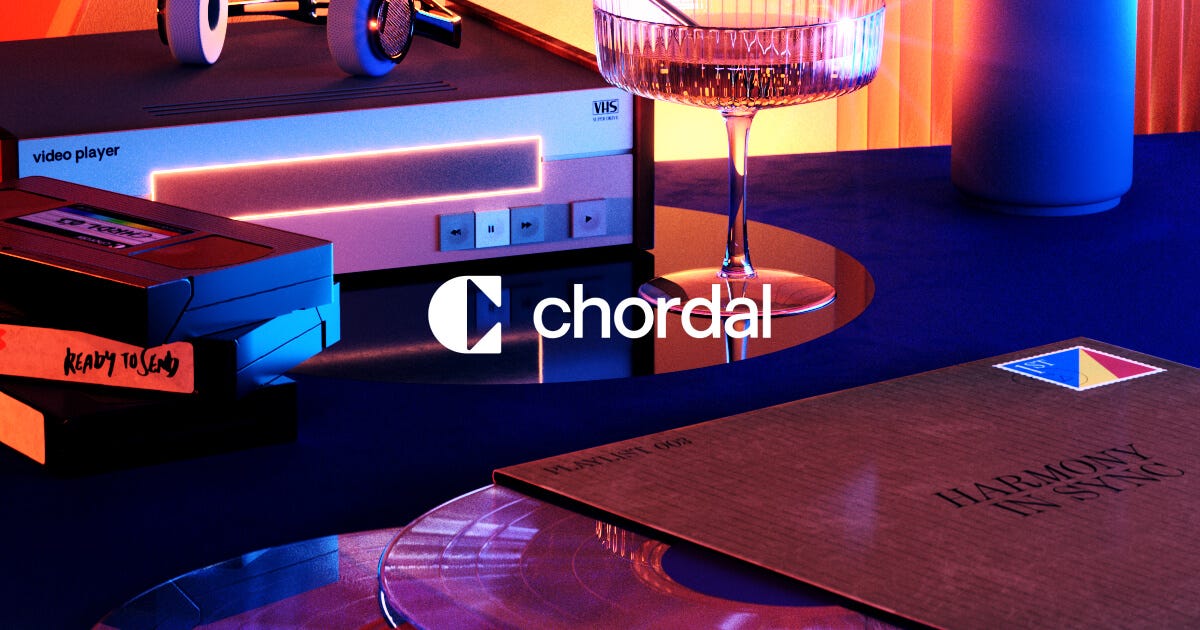Saving Sync: A Conversation with Chordal CEO Grayson Sanders
It's always been painful to get a license to put a song in a movie or TV show. Grayson Sanders is trying to change that.
Last week, I read a head-scratching news headline: “Warner Music Group is suing Crumbl Cookies for ‘massive’ copyright infringement.” How was a cookie company committing copyright infringement at scale? In short, Crumbl was using music owned by Warner labels on promotional content posted to TikTok and Instagram. If you want to advertise with a song, you’ve got to get what’s known as a “sync license,” even if it’s only posted to social media. Crumbl didn’t do that.
Grayson Sanders is an expert on these licenses. Originally an artist, Sanders slowly made his way into the complicated world of sync licensing. His most recent venture is Chordal, a company trying to make sync licensing easier than it’s ever been. If Crumbl had used Chordal, they probably would have avoided this whole mess.
For anyone reading who is not familiar, can you give me a brief overview of what sync licensing is?
Any time a piece of music is paired with media, especially visual media, there needs to be a license in place to do that legally. Music is being paired with media millions of times a day across television, movies, and social media. It also happens every day between media companies, streaming platforms, advertising agencies, and gaming companies. These license negotiations involve labels, publishers, artists, lawyers, and a bunch of others. It can be very complex to navigate. The license is usually granted through a contract. That contract stipulates a fee, what the song can be used for, and how long it can be used.
According to the RIAA, sync revenues in the U.S. have doubled from $200 million to $400 million in the last 15 years. Why do you think that’s happened?
The biggest thing is the explosion of content production globally. Along with more social media sites coming online in the last decade, there are also more streaming platforms than ever before all making huge investments in content. Because of that, there’s a lot more music getting licensed. If you think about it, the internet is all based around video now, and many of those videos have music. That requires a license.
Is it common for social media sites to negotiate sync licenses?
Yes and no. Meta and TikTok have blanket licensing deals, which means that users on those platforms can use music without having to negotiate specific licenses. These blanket licenses have very specific terms, though. You can’t use more than a certain number of seconds. Also, the songs can’t be used by brands for paid advertising.
At the same time, there is still significant copyright infringement going on across these platforms. Sometimes that infringement is accidental. People just don’t realize they need a license. Other times, people know they need a license but don’t bother. Music rightsholders sometimes let this stuff slide because they don’t want to be litigating tons of brands. They don’t want to push those buyers away. But at the same time, we need better systems in place to make sure licenses can be acquired and infringing parties can quickly be dealt with.
That idea that some people don’t realize they need a license is interesting. Your average person doesn’t think about intellectual property rights, especially for something as ephemeral as a song.
Yup. And the system is needlessly complicated because it was built 100 years before everyone on Earth could easily put music to a video.

Beyond social media, do you think other areas will become more reliant on sync licensing in the future?
Syncs for television and film should continue to be quite popular, along with advertising. That said, I really do think that social media in different modalities will continue to proliferate. The creator economy is getting bigger and bigger. Many of those creators need music. As long as that’s the case, we need systems to make sure artists get paid fairly.
What are the biggest pain points in the sync world right now? Is it education? Technology? Politics?
Music licensing is complicated because there are two copyrights associated with every piece of music. One for the composition and one for the recording of the composition. Often, multiple parties are involved with each of those copyrights. Each of them has to sign off on a sync. That process becomes slower and slower as more people are involved. As a result, you end up with many frustrated buyers. Sometimes this results in brands dropping out of the sync market entirely.
“Dropping out” as in not using music at all?
No. They will just use stock music. This is a multi-pronged problem. First, you need to identify who owns the rights. Then you need to track those people down and negotiate. At Chordal —
Just to clarify for those reading, Chordal is the company you founded and run?
Yes. At Chordal, we are trying to simplify the sync process by building a collaborative rights management system. What that means is that stakeholders that own pieces of songs can be in this interactive environment together and see everything they own, along with who else owns the songs that they own. So, a label and two publishers can be viewing their private accounts and seeing the music that they share with one another.
There’s a lot of interesting things you can do within that space. You can collaboratively license something. You can pre-clear your music for certain types of syncs. With that, brands get an instant licensing experience, no negotiation needed. The terms are already set.
That sounds convenient.
That’s what we’re going for. It took us 6 years to get to this point. There are a few other pieces too. We want buyers to be able to come in and painlessly browse and license songs. Then they can pay directly through the system and have that payment split up as it should be. That alleviates most of the lift for the brand. Our hope is that you can now do something in five minutes that used to take so long that it might drive you to use stock music. We want Chordal to make you feel like you’re just making creative decisions and not jumping through confusing legal hoops.
Let’s talk through how this would work in a specific example. A few months ago, I spoke with a music supervisor named Jordan Young. He worked on a television show called Love Island, which is known for syncing scores of songs across a season. Young told me that in order to make the show happen, they needed a team of people pre-clearing songs. How would Chordal affect this process?
Keep reading with a 7-day free trial
Subscribe to Can't Get Much Higher to keep reading this post and get 7 days of free access to the full post archives.




